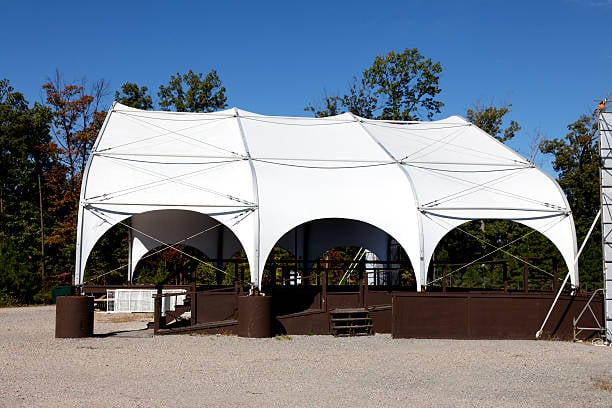Introduction: Exploring the Differences Between Arch Tents and Traditional Tents
When it comes to camping or hosting outdoor events, the choice of tent plays a crucial role in ensuring comfort, durability, and functionality. Two popular options that often come up in this discussion are arch tents and traditional tents. While both serve the same purpose of providing shelter, they differ in terms of structure, design, and overall performance. In this article, we will explore the various aspects of arch tents and traditional tents, highlighting their features, advantages, and drawbacks. So, let's dive in and compare Arch Tents vs. Traditional Tents.
1. Structure: The Unique Shape of Arch Tents
One of the most striking differences between arch tents and traditional tents lies in their structure. Arch tents, as the name suggests, have a curved or vaulted shape, creating a distinctive appearance. This design not only enhances the tent's visual appeal but also offers increased stability and resistance to strong winds. On the other hand, traditional tents typically feature a more conventional A-frame or dome-shaped structure, which may not be as sturdy in adverse weather conditions.
2. Setup and Portability of Arch Tents
When it comes to ease of setup and portability, traditional tents often have the upper hand. These tents are usually straightforward to assemble, requiring minimal effort and time. Additionally, traditional tents are lighter in weight compared to arch tents, making them more convenient for backpackers or hikers who need to carry their shelters over long distances. However, with advancements in technology, some modern arch tents now offer quick and hassle-free setup options, narrowing the gap between the two types.
3. Interior Space and Comfort
When considering interior space, arch tents tend to provide a more generous area for occupants. The arched design allows for a higher ceiling height and more vertical walls, maximizing usable space inside the tent. This is particularly beneficial for individuals who value comfort and need room to move around. Traditional tents, while still offering ample space, may feel slightly more confined due to their sloping walls and lower ceiling height.
4. Durability: Weather Resistance and Longevity
When it comes to durability, arch tents excel in adverse weather conditions. The curved structure of arch tents helps to distribute wind and snow load evenly, reducing the risk of collapsing or being damaged by strong gusts. This makes them an excellent choice for camping in areas prone to high winds or heavy snowfall. Traditional tents, although reliable in moderate weather, may not fare as well during extreme conditions. Additionally, arch tents are often made from durable materials such as reinforced polyester or nylon, further enhancing their longevity.
5. Versatility: Different Applications for Arch Tents and Traditional Tents
Arch tents and traditional tents cater to different needs and applications. Arch tents, with their spacious interiors and sturdy construction, are often preferred for large-scale events, such as weddings, trade shows, or music festivals. Their unique shape provides an eye-catching focal point and can accommodate a significant number of people. Traditional tents, on the other hand, are more commonly used for recreational camping, backpacking, or family trips where portability and ease of setup are paramount.
6. Ventilation and Airflow
Proper ventilation is essential for a comfortable camping experience, and both arch tents and traditional tents have their own approaches to address this. Arch tents often feature multiple ventilation ports and mesh windows, allowing for improved airflow and reducing condensation buildup. Traditional tents, while they may also have ventilation features, may not offer the same level of breathability due to their more compact design. It's important to consider the climatic conditions and personal preferences when choosing between the two.
7. Cost Considerations: Arch Tents vs. Traditional Tents
When it comes to cost, traditional tents generally have a more affordable price range compared to arch tents. The simpler construction and materials used in traditional tents contribute to their lower price point. However, it's worth noting that the cost can vary significantly depending on the brand, size, and additional features of both arch tents and traditional tents. It's important to weigh the cost against the specific requirements and intended use to make an informed decision.
8. Maintenance and Repairs
Maintenance and repairs are inevitable aspects of owning a tent, regardless of its type. Traditional tents, with their simpler designs and fewer components, are generally easier to maintain and repair. In case of damage, it's often possible to patch or replace specific parts without much hassle. Arch tents, with their more intricate structures and tensioned fabric, may require more specialized maintenance and repairs. It's important to follow the manufacturer's instructions and guidelines to ensure the longevity of both types of tents.
9. Eco-Friendliness: Considering the Environmental Impact
For environmentally conscious campers, the eco-friendliness of their tent choice is a crucial factor. Traditional tents, especially those made from natural and biodegradable materials such as cotton canvas, are considered more eco-friendly. They have a lower carbon footprint and are easier to dispose of responsibly. Arch tents, often made from synthetic materials, require proper recycling or disposal methods to minimize their impact on the environment. It's essential to consider the environmental implications when selecting a tent.
10. Conclusion: Choosing the Right Tent for Your Needs
Both arch tents and traditional tents have their own merits and drawbacks, making them suitable for different situations and preferences. Arch tents offer stability, spaciousness, and durability, making them ideal for large events or longer-term camping. On the other hand, traditional tents are lighter, easier to set up, and more budget-friendly, making them a popular choice for recreational camping and backpacking. Ultimately, the right tent for you depends on factors such as the intended use, weather conditions, size requirements, and personal preferences. Consider these aspects carefully, and you'll be well-equipped to make an informed decision between arch tents and traditional tents.

